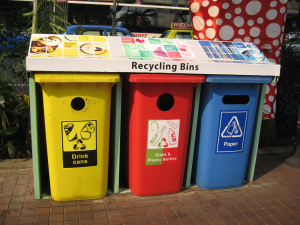 One of the side benefits to spending less money is a reduction of waste. Every time you make a decision to reuse or recycle something, you not only save $$, you also keep that “something” from going to the landfill. A national movement promoting waste reduction is called the Zero Waste Movement.
One of the side benefits to spending less money is a reduction of waste. Every time you make a decision to reuse or recycle something, you not only save $$, you also keep that “something” from going to the landfill. A national movement promoting waste reduction is called the Zero Waste Movement.
The concept of zero waste originated with a company called Zero Waste Systems (ZWS). ZWS was founded by PhD chemist Paul Palmer in the mid-1970s to deal with chemical waste created by the electronics industry.
The Zero Waste concept is comprised of the following principles:
1. REFUSE what you don’t need. Simply put, don’t buy (or even take for free) stuff you don’t need
2. REDUCE what you do need. We all need food, clothing, and shelter. We DON’T need a huge house, tons of clothes, and food that doesn’t get eaten.
3. REUSE what you consume. Can something be repurposed and used again in a different form?
4. RECYCLE what you cannot Refuse, Reduce or Reuse. Instead of dumping items you no longer use into trash, leave them for someone else, sell, or donate to charity.
5. ROT (compost) the rest. Use leftover food scraps, compostable materials, and yard waste to make compost that will supplement your soil instead of becoming buried waste in a landfill.
Where are we now?
Our existing efforts are much improved; many communities in the U.S. have yard waste and packaging recycling. However, burying (landfill), dumping (like in the ocean), and/or incineration are still destruction of Earth’s resources. Zero Waste’s goal is for all products to be repairable, re-manufactured, and/or reused in some other format. For example, online web services such as Free Cycle and the reGives Network are programs where locals can give items that they no longer need to others in their geographic area in an effort to keep those items out of landfills.
Bottom line:
Earth’s resources are limited and finite. As Mahatma Gandhi once said “We must be the change we wish to see in the world.”

